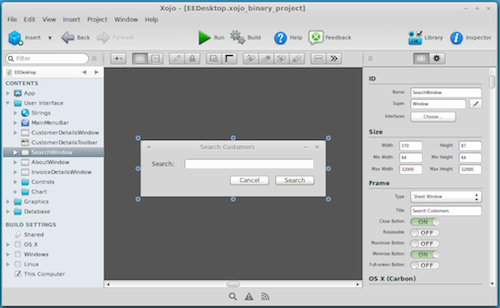

- #Xojo get list of properties in a module software
- #Xojo get list of properties in a module code
- #Xojo get list of properties in a module mac
- #Xojo get list of properties in a module windows
To me that’s much more convenient and efficient than Remote Debugging.
#Xojo get list of properties in a module mac
Commit/Push the changes, switch to a Mac and check-out/pull the current branch you’re working on in order to do some platform specific tests.
#Xojo get list of properties in a module windows
Check out the Version Control Repository on your Windows working machine and start coding. So you cannot only move the MonoRepo folder to any location on your machine, but also to other machines – running the same or a different Operating System. Everything is contained in a single repository/folder, all files are located relatively. I like the MonoRepo setup because of Xojo’s support for cross-platform development.
#Xojo get list of properties in a module software
Depending on the software being developed, this can be a significant amount of “not needed” storage space. Storage: A developer needs to check out the whole MonoRepo, even if one is working just on a single project included in the MonoRepo.A MonoRepo however allows read access to all software in the repository.

 Access Control: With split repositories for each project, access to a project can be granted based upon need.
Access Control: With split repositories for each project, access to a project can be granted based upon need. #Xojo get list of properties in a module code
Shared code can be improved by all developers with the others (or other projects) benefitting, too.
Collaboration: Several developers can work on different projects. So no need to know which project in which version or state has been used in version X. This will include the state of all dependent projects needed for that release. Once the projects are ready for an update, you can tag the current state. Atomic Commits: When several projects work together, releases need to sync which versions work with each other. Reuse Code: Functionality can be abstracted into shared Modules or Classes, and be included in multiple projects without the need of a package management system. What it means: it’s a software development strategy where code for multiple projects is stored in the same repository (and therefore in the same main folder). The name consists of two parts: «Mono» (meaning: single) and «Repo» (short for: Repository). So let’s see how this can be done with MonoRepo. Business Logic Classes can be used in console, desktop and web applications – again, there’s the need to share code. And I want multiple projects that share code such as Modules with Extension Methods and various helper Methods I’ve written over the years. I’d definitely want to use the Xojo Text project format. On the right: «Xojo Text project format» (*.xojo_project). On the left: «Xojo XML project format» (*.xojo_xml_project). Which one would you prefer to read when looking at changes, diffs, conflicts? It is readable in plain text, but not as clean and easy compared to Xojo’s Text format. However, many don’t quite like the XML project format. With a Version Control System such as SVN or Git one should obviously go for XML. The downside is that after making a fix in a shared code item, it needs to be copied and pasted again and again to all projects that are using it.Įxport/Import Items as well as External Items allows to save project items such as Modules or Classes in Binary or XML Format. The Xojo Documentation «Sharing Code» explains three different ways: Copy & Paste between projects, Export/Import Items and as a last option there are External Items.Ĭopy & Paste is the simplest way. That’s not as simple as one might think with Xojo. Other IDE’s have a concept of a solution or workspace consisting of several projects, and you can leverage packages in order to share code between projects. Select -Property Name,DNSHostName,Enabled,LastLogonDate |Įxport-CSV "C:\AllComputersInOU.Are you working on a solution consisting of several projects? Are you working in a team or as a single developer and want to share code between different projects? If so, then a MonoRepo could be something to think about. Get-ADComputer -Filter * -SearchBase "OU=TestOU,DC=TestDomain,DC=com" -Properties * | We can export all computer details to csv file by using the powershell cmdlet Export-CSV. Select -Property Name,DNSHostName,LastLogonDate Export all computers in OU to CSV The following powershell command select all computers from the Organization Unit ‘TestOU’. We can find and get a list of all computers from a certain OU by setting target OU scope by using the parameter SearchBase. Select -Property Name,DNSHostName,LastLogonDate Get list of all computers in OU The following command find and list all the available computers in Active Directory. In this article, I am going to write powershell script to find and get a list of all computers from ceratin OU in AD and export computer details to csv file.īefore proceed run the following command to import Active Directory module. We can get a list of all computers in Active Directory using the Powershell cmdlet Get-ADComputer.







 0 kommentar(er)
0 kommentar(er)
